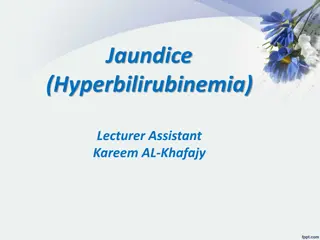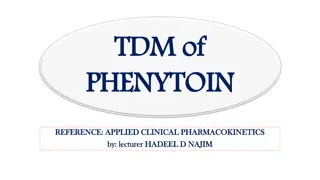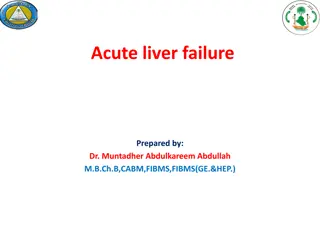Understanding Serum Bilirubin: Types, Estimation, and Causes of Jaundice
Serum bilirubin levels are crucial in diagnosing conditions like jaundice, with total, direct, and indirect bilirubin playing key roles. Excess bilirubin in the blood can lead to jaundice, characterized by yellow discoloration of the skin and eyes. Different types of jaundice, including pre-hepatic, hepatic, and post-hepatic, have distinct causes such as hemolytic disease, liver cirrhosis, and hepatitis. Accurate estimation of bilirubin levels is essential in understanding and managing these conditions.
Download Presentation

Please find below an Image/Link to download the presentation.
The content on the website is provided AS IS for your information and personal use only. It may not be sold, licensed, or shared on other websites without obtaining consent from the author. Download presentation by click this link. If you encounter any issues during the download, it is possible that the publisher has removed the file from their server.
E N D
Presentation Transcript
Estimation of Serum Bilirubin (Total & Direct)
Objective To estimate the amount of bilirubin in serum.
Bilirubin It is a by-product of the breakdown of hemoglobin.
Types of Bilirubin Direct bilirubin: Conjugated with glucoronic acid Indirect bilirubin: unconjugated, insoluble in water Total bilirubin: sum of the direct and indirect of bilirubin. Notes: -About 200 mg per day of unconjugated bilirubin are transported to the liver Above about 2 mg/dl in the blood, leads to disease called Jaundice.
Bilirubin and jaundice Jaundice is caused by a build-up of bilirubin (yellow color) in the blood and tissues of the body. Jaundice is the discoloration of skin and sclera of the eye caused by high concentration of bilirubin.
The causes of jaundice may be classified as: Types of jaundice Pre-Hepatic Jaundice Post-Hepatic Jaundice Hepatic Jaundice -Cirrhosis of the liver Hemolytic disease Cholecystitis. -Infective Hepatitis -Neonatal Jaundice
1-Pre-Hepatic Jaundice Hemolytic disease (excess hemolysis) The production of un-conjugated bilirubin may exceed the conjugating capacity of the liver and hence the serum levels of indirect (and of total) bilirubin will be raised and that of direct in the upper normal range or just a little elevated. excess hemolysis briefly ,Indirect bilirubin ----------- incresed direct bilirubin---------------- little incresed unconjugated bilirubin (in blood) total bilirubin ----------------- increased upper normal range conjugated bilirubin (released to bile duct)
2-Hepatic Jaundice Cirrhosis (in the absence of infection) Destruction of liver cells will lead to a reduced conjugating capacity with a: Raised serum level of indirect (and of total) bilirubin, with a low level of direct bilirubin
2-Hepatic Jaundice Hepatitis (in the presense of infection) The conjugative capacity of the liver is approximately normal, but there is the inability to transport the conjugated bilirubin from the liver cells to the biliary system, and it will be regurgitated back into the blood. Hence: The serum level of unconjugated bilirubin will be normal Normal unconjugated bilirubin (in blood) conjugated bilirubin (in blood) and that of conjugated (and total) bilirubin will be raised.
2-Hepatic Jaundice Neonatal Jaundice Conjugating enzymes in the liver are often absent at birth. Hence: Raised serum level of indirect (and total) bilirubin is to be expected Low level of direct bilirubin. The indirect bilirubin level will rise for the first few days after birth until the conjugating enzymes begin to synthesize. If the conjugation process is delayed and the serum level of indirect bilirubin rises towards 20 mg/dl, an ultraviolet therapy or an exchange blood transfusion should be carried out owing to the danger of deposition of the insoluble unconjugated bilirubin in the basal ganglia of the brain leading permanent Brain Damage.
3-Post-Hepatic Jaundice Cholecystitis The bile duct is blocked. Hence: The indirect bilirubin level is normal but conjugated bilirubin is regurgitated into the blood and excreted into the urine (raised conjugated and total bilirubin). Normal unconjugated bilirubin (in blood) conjugated bilirubin (in blood)
Principle Bilirubin in serum is coupled with diazotized sulphanilic acid to form azobilirubin . The intensity of the purple color that is formed is proptional to the bilirubin concentration in the serum. The water soluble conjugated bilirubin (direct bilirubin) reacts easily with reagents such as diazotized sulphanilic acid. ( with one minute) while the water insoluble unconjugated bilirubin (indirect bilirubin) requires methanol, in order to accelerates the react with the diazotized sulphanilic acid. In this experiment, the direct bilirubin is estimated in the absence of the solubilizing agent and then further bilirubin estimation in the presence of methanole will give the total bilirubin level. The indirect or unconjugated bilirubin is then found by difference.
Method Label 4 tubes as TT (total test), TB ( total Blank), DT (direct test), DB (direct Blank). Direct Bilirubin Test Blank 1.0 ml -- Total Bilirubin Test Blank 0.5 ml -- Test 1.0 ml 0.02 ml Test 0.5ml 0.02ml Sulfanilic Acid Reagent Sodium Nitrite Reagent Mix and let stand for at least 1 min but no longer than 3min then add: Sample 0.05 ml 0.05 ml 0.05 ml 0.05 ml After exactly 1 min . Read the absorbance of test and Test and Test Blank (of Direct bilirubin only) at 546 nm against distalled water . For Total Bilirubin add: -- Methanol -- 0.5 ml 0.5 ml Mix and let stand for 5 min at room temperature and read the absorbance of test and test blank ( of Total Bilirubin) at 546 nm against distilled water
Calculation Concentration of direct bilirubin = (abs. Test - abs. Test Blank ) X 25m= mg /dl Normal range: Up to 0.5 mg/dl Concentration of total bilirubin = (abs. Test - abs. Test Blank )X 25 = mg /dl Normal range: Up to 1 mg/dl Concentration of indirect bilirubin = Conc of total bilirubin Conc of direct bilirubin= mg /dl Normal range: 0.1-0.4 mg/dl























